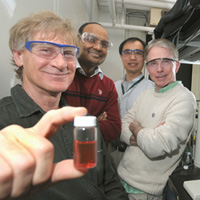Scientists use light to join nanoparticles into new materials
01 Apr 2011
For many years, scientists have searched for ways to assemble nanoparticles-tiny bits of matter less than a millionth of an inch across-into larger structures of any desired shape and form at will. This effect has been achieved in a new study by using a laser as if it were a magic wand, creating an assembled, continuous filament as the laser beam is moved around.
 |
| John Bahns, Subramanian Sankaranarayanan, Liaohai Chen and Stephen Gray find new way to assemble nanoparticles. |
"It's possible that we could use this method to encapsulate pharmaceutical agents for new drug delivery systems or build cathodes with very large surface areas for use in batteries," said Argonne biophysicist John Bahns, who led the invention of the technology. "It could potentially help us find better materials that could be used in everything from catalysts to semiconductors; the possibilities are endless."
Researchers at Argonne National Laboratory shined a low-power laser-similar in intensity to ones used in office laser pointers-into a solution of gold and carbon nanoparticles suspended in water. Unexpectedly, they found that the carbon nanoparticles decomposed or deformed to create a kind of "glue" that enabled the creation of long gold and carbon chains that assembled continuously wherever the laser was pointed.
This new technique for materials design, known as "optically directed assembly" or ODA, could provide scientists and inventors with an uncharted route to new materials, technologies and even treatments for diseases. "It's incredibly exciting to think about the vast world of technology that could result from people using ODA," said Liaohai Chen, who helped to develop the technology. "This is just the very beginning; we really don't even know yet all the things that might be possible."
The research leading to the discovery of ODA sought to develop new methods for imaging dynamic biological processes in living systems. "ODA provides a new way to encapsulate metal particles with inert carbon, which can be harnessed to generate imaging probes for studies of biological systems important to bioenergy research or medical diagnostics," Chen said. "ODA opens a new avenue to synthesize a new generation of nanoparticle-based imaging probes (especially for the metal isotopes) and therapeutic agents with a simple, inexpensive, safer and greener (energy efficient) process" said Chen.
"It could potentially help us find better materials that could be used in wide application spectrum ranging from catalysts, drug delivery to semiconductors," said Bahns.













.jpg)






.jpg)









